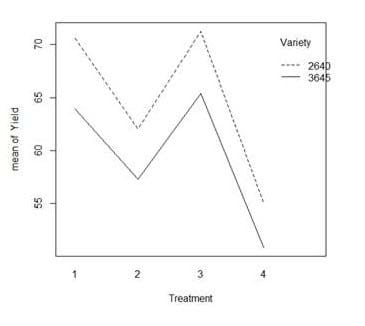Agronomy Update: Replant Simulation - Soybeans
BY DAIRYLAND SEED AGRONOMY TEAM
Introduction/Objective
Every year we face replant decisions in some parts of our geography. Causes are largely weather dependent and include crusted soils and seed and seedling diseases. Replant decisions are always difficult to make. This study will simulate replant situations and look at several potential strategies to address these issues. A similar study was conducted in 2018 and presented in the 2018 Wabash Show Farm Report.
Methods
- Varieties DSR-2640E and DSR-3645E
- 130,000 seeds/acre planting rate, 30-inch rows
- 4 replications
- Normal management practices
- Planted May 6
- Second planting May 28
Treatments
- AS IS - Early planting – Full population, nothing else
- FILL IN - Early planting followed by thinning to 75,000 followed by overplanting 100,000
- LIVE WITH THIN STAND - Early planting followed by thinning to 75,000
- TEAR UP and START OVER - Early planting followed by tear up and replant 140,000
Results and Discussion
Table 1
| Variety by treatment results: | |||||
| Variety | Trtmnt | Moisture | TW | Bu/A | Trt Effect on Yield as % of Trtmnt 1 |
| DSR-2640E | 1 | 13.5 | 53.8 | 70.6 | 100.0 |
| DSR-2640E | 2 | 12.9 | 54.2 | 62.0 | 87.9 |
| DSR-2640E | 3 | 12.8 | 53.9 | 71.2 | 100.9 |
| DSR-2640E | 4 | 12.5 | 54.9 | 55.0 | 78.0 |
| DSR-3645E | 1 | 12.7 | 53.8 | 63.9 | 100.0 |
| DSR-3645E | 2 | 13.0 | 54.6 | 57.3 | 89.6 |
| DSR-3645E | 3 | 12.5 | 53.9 | 65.4 | 102.2 |
| DSR-3645E | 4 | 14.6 | 53.2 | 50.8 | 79.5 |
Table 2
| Treatment effect - averaged across varieties | ||||
| Trtmnt | Moisture | TW | Bu/A | Trt Effect on Yield as % of Trtmnt 1 |
| 1 | 13.1 | 53.8 | 67.3 | 100.0 |
| 2 | 12.9 | 54.4 | 59.7 | 88.7 |
| 3 | 12.6 | 53.9 | 68.3 | 101.5 |
| 4 LSD (0.10) |
13.6 0.56 |
54.0 0.0.47 |
52.9 1.79 |
78.7 |
Figure 1
Graphical presentation of yield differences by variety across treatments

Table 1 (also shown graphically in Figure 1) shows a difference between the two varieties. In general, the 2.6 maturity soybean (DSR-2640E) out yielded the 3.6 bean (DSR-3645E) this year. That is likely due to the late season drought as the month of August had well below normal rainfall (weather data not presented). The 2.6 was likely much farther along in development by the time the drought set in. Table 1, right column, shows the yield of each treatment as a percent of Treatment 1. The differences in treatment effect are very similar for each variety, so for discussion of those effects, we will use Table 2 – Averaged across varieties.
The results in Table 2 show that Trt 2 – thinning and interplanting – resulted in a yield decrease of 11.3 percent (100-88.7) compared to the full stand achieved in Trt 1. Trt 3 – thinning to 75,000 plants and doing nothing more – resulted in a slight yield increase over the early planted full stand. So, comparing the strategy of interplanting to that of doing nothing when stands are quite thin showed that, in this year, doing nothing resulted in the best outcome. Observations in the field: Trt 2 resulted in many spindly and very poorly podded plants that were the “interplants”. They acted mostly like “weed plants” – presumably consuming resources but producing very little. In Trt 3, however, the plants branched profusely and podded heavily, enabling the sharply reduced stands to equal or better the yield of the first planted near 100 percent stand plots.
Treatment 4, simulating a “tear up and reseed” strategy, did not succeed this year probably owing mostly to the late season drought.
Statistical analysis (LSD 0.10 presented in Table 2) shows the yields of Trt 1 and 3 were both significantly higher than the yields of Trt 2 and 4. Trt 1 and 3 were not statically different from each other.
There were some statistically significant differences among the moisture and test weight results, due to treatment effect, but these differences would not seem to be important when considering replant strategies.
These results are essentially the same as the 2018 study (Table 3). Full population and the reduced – thinned – populations yielded essentially the same. The interplanting into the reduced stand and the delayed planting resulted in lower yields.
Table 3
| 2018 Study at Wabash Show Farm | ||
| Date | Treatment | Yield (bu/a) |
| 5/10/2018 | Full population, early planting | 66.0 |
| 2/3 population after thinning | 66.2 | |
| 5/25/2018 | 2/3 population with interplanting | 63.8 |
| 5/25/2018 | Tear up thin planting, replant | 58.6 |
These results suggest that thin stands due to poor emergence may not be a big yield reducer, and the best strategy may be to “do nothing” as shown by Trt 3. Issues for consideration continue to be the evenness or, more likely, unevenness of the thin stands, and the minimum number of plants required to achieve the best possible yields.
 |
 |
 |
 |
 |
| Brian Weller Western Region 507.456.3034 |
Dan Ritter Central Region 219.863.0583 |
Branden Furseth Northern Region 608.513.4265 |
Rod King Eastern Region 574.596.6721 |
Terry Jones Eastern Region 419.630.3115 |
